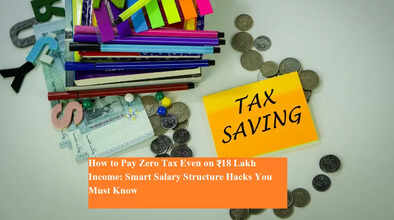How to Pay Zero Tax Even on ₹18 Lakh Income: Smart Salary Structure Hacks You Must Know

With strategic planning and a few clever adjustments to your salary structure, even those earning up to ₹18 lakh annually can legally avoid paying income tax under the new tax regime in India. Sounds too good to be true? Here's a detailed breakdown of how to restructure your income in a tax-efficient way, and make the most of exemptions, deductions, and employer-provided benefits—while staying fully compliant with the law.
Tax-Free Income Under the New Regime: What’s Changed?
The Indian government, in Budget 2025, offered substantial relief to salaried individuals by making annual income up to ₹12 lakh completely tax-free. Add the standard deduction of ₹75,000, and it means those earning up to ₹12.75 lakh need not pay any tax under the new tax regime. But what if your salary is higher—say, ₹13 lakh, ₹15 lakh, or even ₹18 lakh?
Here’s where smart salary structuring comes into play. With the right adjustments, you can bring down your taxable income while still taking home a good paycheck.
Example Scenario: ₹18 Lakh Gross Salary, Zero Tax Liability
Let’s consider a scenario where your gross annual income is ₹18 lakh. By strategically utilizing tax exemptions and restructuring your salary components, you can potentially bring your taxable income down to zero. Here’s how:
Breakdown:
-
Basic Salary + Dearness Allowance (DA): ₹12.25 lakh
-
Employer’s NPS Contribution: ₹1.71 lakh
-
Company Car Lease: ₹4 lakh (approximate tax benefit)
-
Gift Allowance: ₹5,000
These adjustments result in a gross structured salary of approximately ₹18.01 lakh, yet your effective tax liability can be nil.
How Does It Work?
1. NPS Contribution – Section 80CCD(2)
If your employer contributes up to 14% of your basic pay and DA into the National Pension System (NPS), this amount is completely tax-exempt. In the above example, ₹1.71 lakh becomes non-taxable.
2. Standard Deduction – ₹75,000
Every salaried employee is entitled to a standard deduction of ₹75,000 under the new regime, automatically reducing taxable income.
3. Gift Allowance – Section 17(2)(vii)
Employers can offer tax-free gifts up to ₹5,000 per year. It may seem small, but every rupee counts in tax planning.
4. Company Car Lease
Opting for a company car lease policy can reduce your taxable salary significantly. Though taxed under perquisite rules, the benefit calculation often results in lower tax outgo compared to receiving a car allowance in cash.
Additional Tax-Free Components to Consider
-
Medical Reimbursements: If your company pays for medical expenses for you or your family, it may be tax-free up to a certain limit.
-
Meal Coupons: Vouchers like Sodexo or Zeta are not considered taxable up to ₹50 per meal (as per prevailing rules).
-
Mobile and Internet Reimbursement: If your job requires using mobile and internet, and your employer covers the cost, this is fully exempt.
-
House Rent Allowance (HRA): Especially for those living in metro cities, HRA can be 40–50% of basic pay, and is a significant tax-saving tool if you live in rented accommodation.
Final Thoughts: Tax Planning is Not Just for the Rich
Smart tax planning isn’t about evading taxes—it’s about using available legal provisions to reduce tax burden. Even if you earn above ₹12 lakh, you can still save significantly by optimizing your salary components and availing exemptions that the new tax regime allows.
So before the next financial year rolls in, speak with your HR or payroll team and restructure your salary smartly. A few tweaks today could lead to zero tax tomorrow—even on ₹18 lakh

